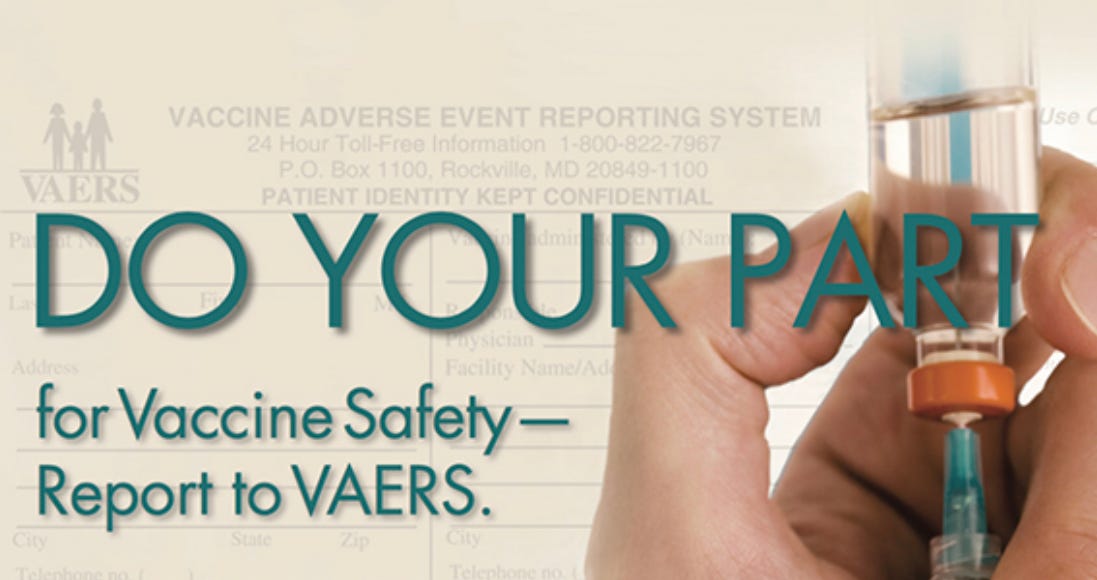Launched: The Reporting Hesitancy Survey #1
Help us identify & solve primary causes of under-reporting of adverse events following vaccination.
Across the globe, Vaccine Injury Reporting Systems are failing us. These tax-funded monitoring systems have one job: identify problems and danger signals related to vaccine medicines approved for public use. How are they failing? Under-reporting.
The Reporting Hesitancy Project asks, “Why?”
This survey is your opportunity to help us answer this key question by identifying primary causes of “reporting hesitancy.” Without your participation, we cannot accurately answer this question.
Ready to go?
Here it is: https://survey.marchtwisdale.com
Over the past sixty years, western civilization has been groomed to dismiss adverse events following vaccination. The reasons are many, but the result is singular. Without adequate feedback, our reporting systems cannot alert us to dangerous products. Every unreported trend or cluster of injuries is a missed opportunity to send up a flare, suggest caution and justify investment in research and solutions.
These systems are failing us, because we are underusing them, but again, “Why?”
Our survey pertains to Australia, New Zealand, Canada, the United Kingdom, the European Union and the USA.
In the USA, the Vaccine Adverse Events Reporting System (VAERS) was created in 1990 by the CDC and FDA, and by the year 2000, their own internal reports concluded that less than 10% of adverse reactions were being reported. Then, it got worse. In 2010, Harvard Pilgrim Health Care completed a CDC-collaborative research project into VAERS reporting. This 3-year long study stated: “Adverse events from drugs and vaccines are common, but underreported. Although 25% of ambulatory patients experience an adverse drug event, less than 0.3% of all adverse drug events and only 1-13% of serious events are reported to the FDA (via the VAERS system).”
How can consumers of vaccine medicine be protected, if our primary consumer reporting system is a failure?
Why has this occurred?
What, exactly, is causing injuries to go unreported?
How can we fix these systems?
The Reporting Hesitancy Project aims to answer these questions by listening to citizens across the western world. With this survey, we will identify primary causes of hesitancy, both internal and external. Our team will analyze the data, explore the full scope of each “category of hesitancy,” and propose solutions. Under-reporting must be replaced by adequate reporting, and to do this, we need a sea change in expectations.
If you doubt the importance of consumer protections, imagine the world today, if the following recalls had never happened? Tainted baby formula and pet food. Faulty ignition and brake systems in cars. Toys with harmful chemicals or magnetic pieces swallowed by toddlers. Even Keurig Brewing Machines! In December 2014, 7.2 million units of the Mini Plus Brewing System were recalled, and they faced a civil penalty of $5.8 million. If 200 reports of water overheating and 90 reports of scald-related injuries can have this effect, imagine the improvements we might see in vaccine medicine, if 90% of injuries were reported?
Survey #1 will ask you a few simple questions. They are not multiple choice. We want to hear your thoughts, unlimited by our best guesses, biases or expectations. Everyone can participate, whether they have personal experience with vaccine injury or not. As a member of society, you are holding the key to our better understanding. Thank you for your time.
Please share our Reporting Hesitancy Project Survey #1: https://survey.marchtwisdale.com
P.S. Many thanks to those who have stepped up to join our Launch Team. Your support is greatly appreciated! We couldn’t have done this without you.






As far as capturing a near complete universe of the adverse events associated with vaxxination, VAERS was built to fail by design, plus the voluntary nature of it will always lead to under-reporting. That being said, VAERS has produced unmistakable danger signals with regards to the covid vaxxines that should be obvious to anyone who bothers to do a simple comparison against the other traditional vaxxines. So the greatest single point of failure is not VAERS itself, but the people who are tasked with investigating signs of harm that VAERS is revealing. They are either completely incompetent (hard to believe), or they are intentionally ignoring the danger signals. VAERS itself is an antiquated (technology-wise) system which could have been replaced back in 2010 during that Pilgrim Healthcare study, during which, if the CDC chose to move forward, a new system could have been implemented that would be more transparent and would allow for real-time electronic collection of data and integration into healthcare systems such that doing root cause analyses would be more efficient and accurate. The fact that they did not choose to move forward with such a new system tells you everything you need to know. The data inside the VAERS system is poorly QC'd and maintained and overall reveals gross negligence at best. Yet despite all this, the signals of unprecedented human harm are clear.
https://vaersanalysis.info/2021/09/21/what-does-the-quality-of-the-vaers-data-tell-us-about-the-most-intense-safety-monitoring-in-us-history/
You are incorrect about reporting the vaccine adverse effects.
Here is what the 2007-2010 Harvard Pilgrim Health Care study found:
"Although 25% of ambulatory patients experience an adverse drug event, less than 0.3% of all adverse drug events and 1-13% of serious events are reported to the Food and Drug Administration (FDA). Likewise, fewer than 1% of vaccine adverse events are reported."
Only 1% for vaccine!!!